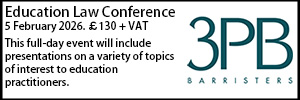Children with EHC plans who move areas
- Details
 A recent case has highlighted the fraught relationship between s.39 and s.33 of the Children and Families Act 2014. Katherine Barnes looks at the lessons to be learned.
A recent case has highlighted the fraught relationship between s.39 and s.33 of the Children and Families Act 2014. Katherine Barnes looks at the lessons to be learned.
The case of R (An Academy Trust) v Medway Council and Secretary of State for Education [2019] EWHC 156 (Admin) is undoubtedly an unusual one with (one hopes) unusual facts. Nevertheless, it contains some useful guidance for all practising in the field of special educational needs law.
In this claim for judicial review an Academy, which had been named by Medway when a boy (X) moved from Greenwich to Medway, successfully challenged the Education, Health and Care Plan (“EHCP”) for a boy, X, with Autistic Spectrum Disorder. When asked by Medway to accept X, the Academy refused, considering itself unsuitable. Rather than looking for alternative school, Medway decided to amend the EHCP and formally name the Academy. The result of this (as per s.43 of the Children and Families Act 2014 (the “2014 Act”)) was that the Academy was compelled to accept X. In amending the EHCP Medway also removed significant parts of Section F, which is required to specify the special educational provision a child needs. These amendments were made without gathering any additional evidence.
The Academy’s primary submission was that Medway’s amendment to X’s EHCP was irrational because it was unsupported by evidence. Medway argued that it had considered the evidence on which the Greenwich EHCP was based and had reached a different conclusion in light of it. While there was no dispute that Medway was entitled to do this in theory, Philip Mott QC (sitting as a Deputy High Court Judge) concluded the evidence did not support a finding that Medway had done this in a rational manner. In particular, amended Section F was inconsistent with Section B. For example, the Medway plan in Section B recognised a need for signing for communication but then failed to provide for this in Section F.
The Judge went on to consider the part of the EHCP which named the Academy, which was the Academy’s real complaint. As the Academy had been requested by X’s parents, s.39(3) of the 2014 Act required it to be named in the EHCP unless one of the exceptions in s.39(4) was met. The Academy contended that it was unsuitable such that the s.39(4)(a) exception applied, Medway argued it was not unsuitable. The Judge concluded that Medway’s decision under s.39(4)(a) was unlawful. In short, this was because: first, there was no contemporaneous evidence to show the rationale for the s.39(4)(a) decision; secondly, there was no explanation for the significant discrepancy between the Greenwich and the Medway Section Fs; and, thirdly, without a coherent Section F Medway had no basis for taking a lawful decision under s.39(4)(a).
One of Medway’s secondary arguments was that any unlawfulness in respect of the s.39(4)(a) decision did not matter because the presumption in favour of mainstream in s.33 of the 2014 Act meant it was highly likely that the Academy would have been named in any event. In addressing this the Judge provided helpful guidance at [93]-[95], well worth reading in full, on the interaction between s.39 and s.33. The key point is that the only gateway to s.33 is s.39(5)1, which requires the local authority to name a school “which the local authority thinks would be appropriate for the child”. In turn, the only gateway to s.39(5) is where one of the conditions in s.39(4) applies (the requested school is considered unsuitable or attendance there by the child would be incompatible with the provision of efficient education of others or the efficient use of resources).
As for how “appropriate” in s.39(5) is to be understood, the Judge found that this must be interpreted in light of the s.33(2) duty to provide mainstream schooling (unless it is incompatible with the parents’ wishes or would be incompatible with the efficient education of others). There is therefore no “suitability” exception in s.33(2). This means that “appropriate” in s.39(5) does not means suitable – it refers to a school which allows the local authority to comply with its strict, though not absolute, obligation in s.33(2). This means that a school could avoid being named under s.39 because it is unsuitable but end up being named under s.33.
However, on the facts here the Judge was not prepared to accept that Medway had demonstrated it was highly likely the Academy would have been named under s.33(2) in any event.
The case is a cautionary tale for local authorities. When a child with an existing EHCP moves into a new area then the new local authority is entitled to amend the EHCP without a review (see [32]). However, careful consideration must be given to the existing evidence base and where the new authority decides to depart from the conclusions of the previous authority, the rationale for this should be properly explained. More broadly, the case is a reminder that shortcutting to s.33 is unlawful. Rather, the decision-maker should work through s.39 before, where relevant, considering s.33. Finally, schools should note that, in appropriate cases, judicial review can be a powerful tool for challenging heavy-handed behaviour by local authorities in the special educational needs context.
Katherine Barnes is a barrister at 39 Essex Chambers. She can be contacted































